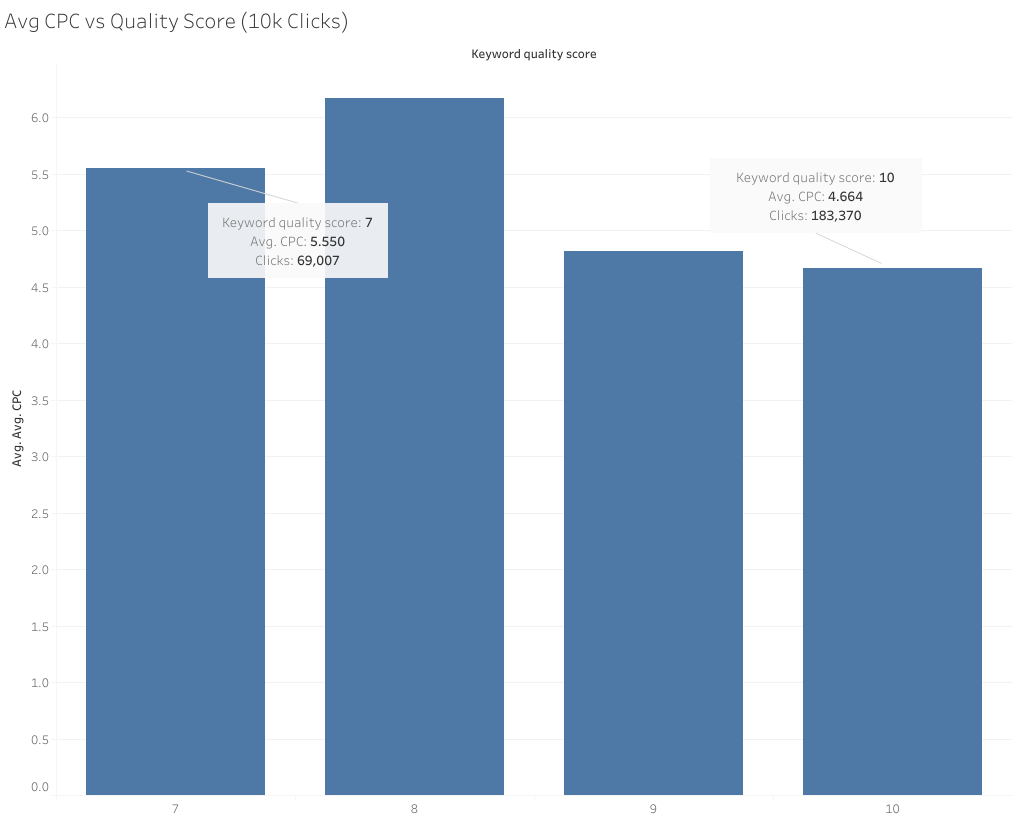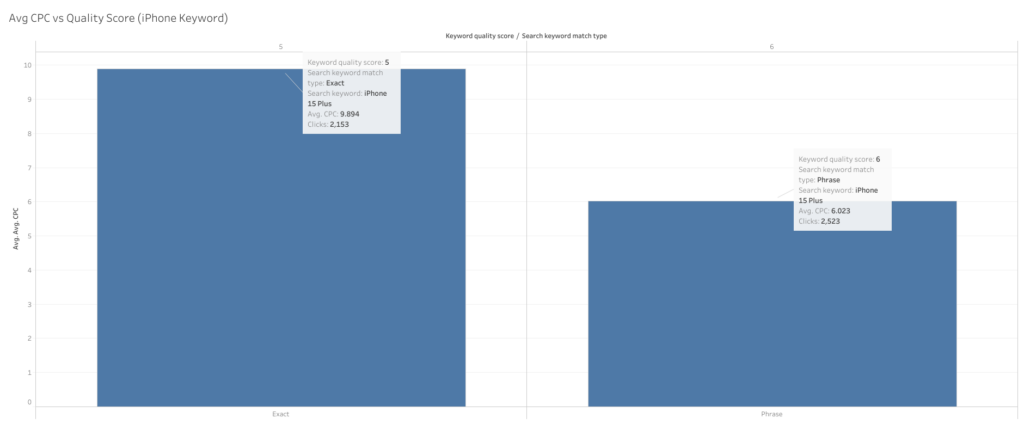The results are surprising, Quality Score and Cost Per Click are more clearly correlated when you look at Exact Match keywords.
close

The Google Ads quality score is a diagnostic tool meant to help you improve your Ad Rank.
A higher Quality Score can result in benefits such as higher ad positions, lower costs per click, and potentially a better return on investment for your advertising efforts. Source: Google

Therefore, advertisers often strive to optimize their campaigns to improve Quality Scores and enhance the overall effectiveness of their online advertising.
In the past, I’ve written a few case studies where I managed to dramatically reduce the average cost per click. I used Quality Score to measure the change.
Google Ads continues to change, so in this case study I set out to explore more broadly how Quality Score works with Cost Per click.
The results are surprising, Quality Score and Cost Per Click are more clearly correlated when you look at Exact Match keywords. Broad Match keywords seemed the have the smallest measurable correlation.
In the first visualization, we looked at the keyword data for 299,916 clicks, Exact Match, Phrase Match, and Broad Match. The keywords had to have more than 10,000 clicks to be included in the dataset.
The data illustrates that there is a subtle variation in the Cost Per Click (CPC) corresponding to different Quality Scores.

While the general pattern suggests a correlation between Quality Score and CPC, the specific dynamics between Quality Scores 8 and 10 reveal interesting variations, emphasizing the need for a nuanced understanding of the relationship between Quality Score and Cost Per Click.
To quantify these variations, we can calculate the percentage changes in CPC from one Quality Score to another.
These percentage changes provide a more quantitative perspective on the observed trends. The CPC increases by approximately 11.27% when transitioning from Quality Score 7 to 8, indicating a moderate upward trend. In contrast, there is a notable decrease of about -20.53% in CPC when moving from Quality Score 8 to 10, suggesting a potential cost reduction associated with a higher Quality Score.
The challenge with the initial visualization arises from the varied distribution of costs associated with each keyword. In typical AdWords accounts, keywords don't span the entire 1-10 range but tend to cluster in specific intervals, like 5-7 or 8-10 for brand terms. Without proper filtering, the inherent relationship may be unclear. To mitigate this, I refined the results by focusing on Exact match keywords with an average CPC above $5, resulting in a sample size of 183,006 clicks.

Upon implementing filtering, a significant trend becomes apparent. Notably, when we focus on exact match keywords, the results become more elucidating. For instance:
Calculating the percentage changes between these Quality Scores provides further insights into the nuances of the relationship:
These percentage changes highlight the diminishing costs associated with higher Quality Scores, reinforcing the importance of refining the analysis through precise filtering to uncover more meaningful insights.
Quality Score is based on historical impressions for exact searches of your keyword, therefore changing keyword match types will not impact Quality Score.
Source: Google
Google states that the quality score is solely influenced by exact match variants in the alignment between a search phrase and a keyword. In theory, match type should be irrelevant to the quality score. I propose that the observed differences may stem from how broad match types can bid on search phrases that are not exact matches, with potentially weaker quality scores, thus influencing their average cost per click.
Match types will not affect your Quality Score, but from the collected data, there seems to be an impact on your average cost per click. In the above two visualizations, we saw little change in Avg CPC when we included Broad Match keywords. In the next visualization, we will include both Exact and Phrase match keywords for a single keyword.

Digging deeper, I honed in on a specific keyword: "iPhone 15 plus." Due to the aforementioned limitation, that most quality scores for a given Adwords account will fall within a small range, our data is confined to quality scores 5 and 6.
This makes sense as a keyword's quality score wouldn't logically fluctuate widely.
The total sample size was 4,676 clicks.
For Quality Score 5, the average CPC was $9.89, while for Quality Score 6, it dropped to $6.023, indicating a decrease of approximately -39.14%.
The percentage change between Quality Scores and Average CPC falls within a range between -10.89 to -28.38% across 183,006 clicks.
To calculate the average range of percentage change between Quality Scores and Average CPC, you can sum up the individual percentage changes and then divide by the number of changes. Using the provided data:
Average Change= 3 ∣−10.89∣+∣−24.61∣+∣−28.38∣
Average Change= 63.88 | 3
Average Change≈21.29%
Therefore, the average percentage change between Exact Match Quality Scores and Avg CPC is approximately -21.29%.
The results are surprising, Quality Score and Cost Per Click are more clearly correlated when you look at Exact Match keywords.
I love WordPress for its customizations. Styling code snippets enhances user perceptions. Copy and paste the code below to style your WordPress code blocks.
The code snippet plugin changed my life. I no longer edit the raw PHP files to add simple functions like titles to users' profiles.
By restructuring your account and using hyper-targeted ad text, CPA can be reduced.
YMYL stands for "Your Money or Your Life." Google uses YMYL to help understand if a web page's main content could impact people's safety, health, or financial well-being.
With slight modifications to Optinmonster's native A/B testing capabilities, it becomes an excellent CRO testing tool.

The results are surprising, Quality Score and Cost Per Click are more clearly correlated when you look at Exact Match keywords.
I love WordPress for its customizations. Styling code snippets enhances user perceptions. Copy and paste the code below to style your WordPress code blocks.
The code snippet plugin changed my life. I no longer edit the raw PHP files to add simple functions like titles to users' profiles.
By restructuring your account and using hyper-targeted ad text, CPA can be reduced.
YMYL stands for "Your Money or Your Life." Google uses YMYL to help understand if a web page's main content could impact people's safety, health, or financial well-being.
With slight modifications to Optinmonster's native A/B testing capabilities, it becomes an excellent CRO testing tool.
